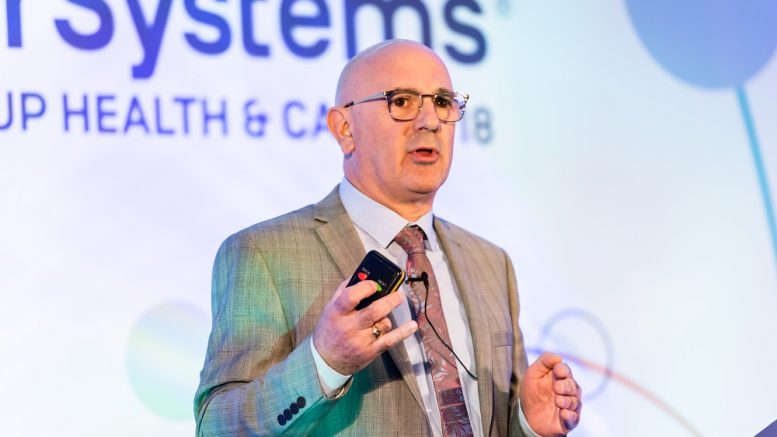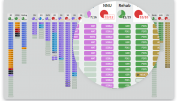By aligning people, process and technology, chief information and technology officer Dr Graham Evans outlines how North Tees and Hartlepool NHS Foundation Trust has created the building blocks for clinically-led digital transformation and joined-up health and care.
Let us be clear. Digital transformation is not easy, especially in the NHS. It means working with patients, professionals and vendors to create an environment that sees technology as an enabler, rather than an obstacle to the delivery of care.
At North Tees and Hartlepool, our vision has been to develop that culture, by aligning people, process and technology, and working in partnership with stakeholders. It has been a significant effort, but now we are starting to see the benefits through innovations that are delivering joined-up health and care and the right patient outcomes.
Our vision has been to abide by the mantra of WWW – work with the willing. By winning the hearts and minds of people, we have been able to get staff to embrace and lead transformational change.
Putting people first
To help achieve this vision, we have set out a digital roadmap that aims to create opportunities and conditions in healthcare “not just to do the same things better”, but to do “better things”.
This is being achieved by embedding the clinical voice in digital decision making.
We have appointed a chief clinical information officer; a chief nursing information officer is soon to follow. The medical director sits on the digital project board. Representatives from all clinical specialities are involved in decision making.
Clinicians were heavily involved in the tender process and in choosing TrakCare from InterSystems as the trust’s electronic patient record (EPR). They continue to be involved today.
The digital programmes team have worked with clinicians across the trust, understanding their workflows and processes, and then identifying what technology is needed to drive the necessary change.
The digital team worked with staff to embed the EPR and replace legacy systems, and also install vital infrastructure such as estate-wide wifi and delivering productivity improvements through the Scan4Safety programme. We work with our suppliers to ensure that the technology evolves to meet the needs of our staff, and the organisation as a whole.
Enterprise-wide engagement is essential. By listening to staff, and providing the tools they need to do their jobs, we now see they are more prepared to embrace technology on projects such as electronic prescribing, handover, discharge, and e-observations.
Understanding process change
Implementing healthcare technology has a profound impact on processes of care. By listening to staff, mapping out their workflows, and identifying their pain points and gain creators, we are now providing them with tools that make a real difference.
For example, clinical staff can now access diagnostic images, patient notes and the GP record electronically at the point of care, rather than have to negotiate access through disparate systems.
Clinicians can be confident they have what they need to make informed clinical decisions, helping to reduce treatment delays and potential errors.
We are also looking to support more efficient, patient-centred models of care, for example through hospital at home services and virtual consultations. We want to shift health and care from ‘isolation to integration’, and this means sharing information – and sometimes resources – across partner organisations.
Such activity is encouraging staff to recognise how serious we are about using technology. As a result, they increasingly come up with their own ideas on how they can use technology as part of care.
For example, one clinician working in complex fractures has recognised that, by having data in a single place, he can more easily provide a picture of the procedures undertaken at the trust, and identify those that might better be performed in other treatment centres.
We also work closely with our suppliers to ensure that we adapt the technology to meet the needs of the clinical process.
Such a flexible approach means that implementations such as our electronic prescribing and medicines administration project are welcomed by staff of all digital abilities. As a result, we expect to realise massive benefits in terms of error reduction, medicines optimisation, and becoming paper-light.
Using the right technology
Choosing the right technology has also been a crucial enabler to us achieve our vision. We are looking to get the basics right, with the right infrastructure, hardware, software and devices.
We are providing Single-Sign-On in selected clinical areas where multiple systems are regularly in use. We support paperless working through easier access to portable devices. These are examples of how we are helping to deliver on our roadmap themes of faster, real-time access to information, and more productive ‘digital clinicians’.
TrakCare is the lynchpin for our delivery roadmap. It has helped us consolidate systems and software to deliver an enterprise-wide solution that improves the clinical and patient experience of care, and puts us on course to save almost £8m and over 50,000 hours of NHS staff time through digital transformation.
The system has replaced numerous legacy systems, such as our Patient Administration System and a home-grown theatre system. This has saved hundreds of thousands in licence fees, and means we do not have to look to additional systems to provide core functionality.
Using TrakCare for e-observations, for example, will help us give timely and appropriate care for deteriorating patients. As a result, it is forecast that the trust’s mortality rate for avoidable deaths will fall by an average of 15%.
Staff time is also saved through more rapid access to information. Referrals can be done in one place, cutting the time previously taken to assemble such information from different systems.
As a result of our approach, North Tees is now ranked as joint 1st on February’s Clinical Digital Maturity Index (CDMI), up over 100 places from 4 years ago. It has been named as a Global Digital Exemplar Fast Follower, which will allow us to share our experiences with other NHS organisations looking to make the most of digital health.
Ultimately, by working in partnership with people, underpinned by the right processes and technology, we can now deliver benefits around patient safety, productivity, and efficiency – for the good of the patient, the clinician and the system as a whole.





